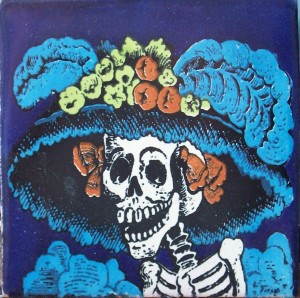(written for CreepyLA.com)
 One of the first ghosts to arrive for el Dia de los Muertos each year is the familiar image of La Calavera Catrina. Shown as a grinning female skeleton wearing a fancy, flowery, broad-brimmed hat, the well-dressed corpse shows up just about everywhere towards the end of October. You’ll find her stationed on traditional altars and cut into colorful paper banners, as well as adorning t-shirts, appearing in video games, and sanctifying other pop culture shrines. She’s become a sort of unofficial patron of the modern Day of the Dead, but she didn’t begin her long, strange afterlife that way.
One of the first ghosts to arrive for el Dia de los Muertos each year is the familiar image of La Calavera Catrina. Shown as a grinning female skeleton wearing a fancy, flowery, broad-brimmed hat, the well-dressed corpse shows up just about everywhere towards the end of October. You’ll find her stationed on traditional altars and cut into colorful paper banners, as well as adorning t-shirts, appearing in video games, and sanctifying other pop culture shrines. She’s become a sort of unofficial patron of the modern Day of the Dead, but she didn’t begin her long, strange afterlife that way.
José Guadalupe Posada was an engraver and printmaker working in Mexico City around the turn of the 20th century. His cartoons graced the pages of newspapers as well as advertising posters and the cheap leaflets that graphically illustrated the events of the day for a largely illiterate audience. Best known were his Calaveras, a series of caricatures depicting costumed skeletons going through the motions of everyday life. La Catrina was one of these, originally published as a broadside sometime around 1910.
The Calaveras were a form of social satire, poking fun at rich and poor alike and reminding everyone that death awaits us all, regardless of status or wealth. La Catrina and her ostentatious hat first served to lampoon the pretentions of the upper classes, who at that time were desperate to emulate European style and culture. The contemporary face of the Day of the Dead first came into the world as an ephemeral political cartoon.
Her current popularity transcends her ironic origin, however. The century-old print has inspired generations of craftspeople, and creative variations on the Catrina theme in a variety of media have become a staple of Latin American art. She has been loosely identified with Mictlancihuatl (also called Mictecacihuatl, the wife of death god Mictlantecuhtli), who oversaw the Aztecs’ Feasts of the Dead, observances which eventually syncretized with the Catholic holidays of All Saints’ and All Souls’ Days to become the Dia de los Muertos celebration we know today. On the darker side of things, she even resembles the ominous figure of Santa Muerte (Holy Death), an unofficial folk saint who is venerated, often in secret, by the disenfranchised throughout Mexico and the Spanish-speaking US. For her followers, the afterlife feels uncertain and intangible, but death itself remains a starkly immutable fact. As Death’s personification, Santa Muerte (also called ‘La Flaca,’ or the Skinny Lady) can be petitioned to show mercy when the dreaded end at last arrives.
José Posada’s old cartoon would seem to have tapped into something that resonates more deeply than the artist’s original socio-political intentions. The image of the elegant skeleton speaks to our fundamental desire for our lives and our identities to continue on beyond the grave. La Catrina’s post-mortem finery hints that maybe we can take it with us, after all— or at least come back once a year to enjoy everything we’ll miss.